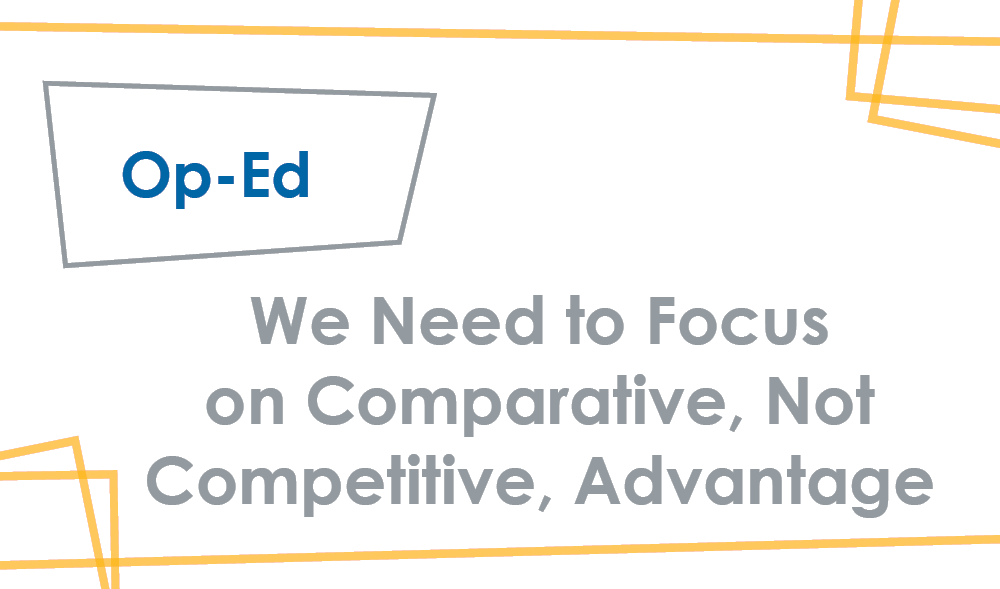We need to focus on comparative, not competitive, advantage
May 2, 2019 - This column first appeared in Northern Ontario Business.

Investments that build on comparative advantage are about building companies where they should be.
At what point did we forget about comparative advantage? The idea that because of the unique characteristics of our communities (geographic, demographic, environmental, physical), we have a global advantage in producing certain goods. That by producing those goods, we create an opportunity to trade them with others in exchange for things we can’t produce so easily and efficiently. Creating, as a result, economic value for ourselves and for our trading partners.
This was how the mining cluster in Sudbury was built. We realized that, because of our unique global position (our proximity to vast mineral wealth), we had an advantage over our competitors. We could produce raw natural resources as well as marketable skills and expertise at a much lower cost and higher efficiency than other communities could. We could test new technology on a more frequent basis (and at lower marginal costs than others) and sell it at a better price while still making a healthy profit.
This is sound economic theory, proven over and over in practice. Aside from Sudbury’s mining cluster, think culture: boating and tourism in Kenora, or logistics and remote service and supply in Sioux Lookout, or assaying and associated testing services in the Timmins area. One of our biggest challenges in relation to government “innovation” or “economic development” policy, however, is that we focus not on comparative, but on competitive, advantage.
Can Company A sell this widget at a cheaper price than Company B? That is a very different question than whether Company A should even be making widgets in the first place. Or rather, whether they should be making those widgets here in Northern Ontario. Into the competitive advantage equation goes very different factors. The price of land, the cost of labour, construction costs, overall tax burden. These things are much easier to measure and much easier for government to manipulate.
Yes, we could produce oranges in Red Lake, or build cars in Chapleau. With a large enough subsidy, the firms involved could even make a profit. The challenge is that when you try to overcome a lack of comparative advantage by enhancing an individual firm’s competitive advantage, the subsidies can never end. The firm’s location will always be a disadvantage.
In defence of policymakers, it is easy to get confused. Policy related to both comparative and competitive advantage deliver the same things in the end: lower prices for the end consumer and higher profits for the companies making the goods. The critical difference, though, is that investments that build on comparative advantage are about building companies where they should be. Competitive advantage is about bribing companies to locate where we want them to be.
Our current obsession with clusters and superclusters is about comparative advantage. That is a good thing. But these efforts often become focused on creating a cluster of similar companies, or worse, the attraction of existing companies. Back once again to using taxpayers’ dollars to bribe companies to move where we want them to be instead of helping them thrive in the locations where they should be.
The best comparative advantage policies focus on the supply chain and creating value throughout it. The supply chain is every step in the process from hewing the wood or drawing the water, through to flipping the light switch to turn on your energy-efficient biomass-powered desk light. Innovation and value-adding happens at every step in that process.
Again, consider mining: underground mining equipment has made leaps and bounds, remotely operated mining equipment is rapidly expanding, and underground safety is a huge business. All of that before we even get into transportation or processing. Similar opportunities abound in areas like agriculture, forest biomass, Indigenous tourism and Northern infrastructure design and construction, just to name a few.
We are very bad at understanding supply chains and even worse at leveraging them for growth. Those types of investments take time both to identify and then to bear fruit. In an age of instant gratification, government that moves at the speed of economic (not technological) adoption is a hard sell indeed. If we want to grow sustainable economic opportunity for our future, however, we need to buy in and be patient.
Charles Cirtwill is the founding President and CEO at NPI.
The content of Northern Policy Institute’s blog is for general information and use. The views expressed in this blog are those of the author and do not necessarily reflect the opinions of Northern Policy Institute, its Board of Directors or its supporters. The authors take full responsibility for the accuracy and completeness of their respective blog posts. Northern Policy Institute will not be liable for any errors or omissions in this information, nor will Northern Policy Institute be liable for any detriment caused from the display or use of this information. Any links to other websites do not imply endorsement, nor is Northern Policy Institute responsible for the content of the linked websites.
Northern Policy Institute welcomes your feedback and comments. Please keep comments to under 500 words. Any submission that uses profane, derogatory, hateful, or threatening language will not be posted. Please keep your comments on topic and relevant to the subject matter presented in the blog. If you are presenting a rebuttal or counter-argument, please provide your evidence and sources. Northern Policy Institute reserves the right to deny any comments or feedback submitted to www.northernpolicy.ca that do not adhere to these guidelines.
